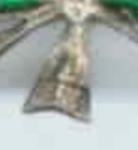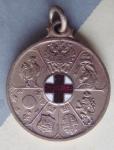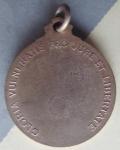-
Posts
1,112 -
Joined
-
Last visited
-
Days Won
1
Content Type
Profiles
Forums
Blogs
Gallery
Events
Store
Everything posted by Hendrik
-
Hello PK, I had a look to determine what is the medal depicting the warrior (top right in your picture in the first post) as I wasn't familiar with it. I've now found it is a non-official award for the Spanish Campaign as manufactured, in 1938, by the firm of Lorioli well before the official Volunteers Medal was created in 1940. Its ribbon should be crimson with thin white-red-yellow-red-white stripes in the centre. Between the warrior's feet should be the designer's name AFFER. Here's pictures of the official type for Spanish Civil War Volunteers : Cheers, Hendrik
-
Hello Jacques, You're probably thinking of the War Merit Cross ... this one is on a ribbon with red, blue and yellow : Cheers, Hendrik
-
Oh great, Belgian French language officialese ... you can't but hate it Here goes : Leopold III, King of the Belgians, To all those present and to come, our greetings. Wishing to extend to Mr. ....., "sagnais" (don't think this is the right word, please check) to the court of Her Majesty the Queen of the Netherlands, our benevolent recognition, we have decided and decide : Art. 1 the 3rd class medal, instituted by our Decree of 2 April 1934, is awarded to Mr. .... - "pregnalifie" (again I think you misread the word here) Art. 2 The Head of our Office is charged with the execution of the present decree. Given in Brussels, 27 December 1938 "Se" (Could that be SA = Son Altesse = His Highness ???) Leopold For the King : Head of the King's Office Baron Capelle Certified for conformity : The Secretary to the King's Office
-
Hello Jerome, Wonderfull bit of research ! Many thanks for digging up the fascinating information and sharing it Cheers, Hendrik
-
-
... or Henry (although the French would normally write that as Henri !).
-

Serbia Online resources for S. European & Balkan States
Hendrik replied to JimZ's topic in Southern European & Balkan States
WW2 medals of Portugal, Spain, Italy, Greece, Croatia, Yugoslavia (as it was then known) : Hendrik's Medal Corner Cheers, Hendrik -
Hello Igor, Lovely medal with the rare Traktir bar ! The officer's name is just about impossible to read ... having a guess : Thierry Vernay ??? Cheers, Hendrik
-

Greece - WW2 Air Force Decorations
Hendrik replied to Hendrik's topic in Southern European & Balkan States
Hello Jim, No idea ... it's all Greek to me The best I can come up with is that someone at the time was so inspired by the British (and Commonwealth) help in trying to withstand the German/Italian invasion that the diagonally striped ribbon was introduced. If my information is correct, the Greek DFC, DFM, AFC and AFM all originally had diagonally striped ribbons (created in 1941 but never struck as medals then, only ribbons appear to have been available). In a short span of time, some of these awards went through 3 different ribbon variations ... Hoping somebody will come up with some picture material and further information on this. Cheers, Hendrik -
Wrong colours for the TOE I believe ... I'm more inclined to think it's a French Croix de Guerre (WW2) fourrag?re. Cheers, Hendrik
-
Rob, Nothing more definite datewise as that it was first "described" some time in the 1920's. The diameter seems to make it the middle of the 3 possible types. Just a guess : maybe the size grew smaller as Italy found itself a bit short in metal sources as its wars went on ? If so, that would could make yours a 1930's one ... anyway, in view of there being a consulate-general being present in London, I'd say a pre-WW2 award. Cheers, Hendrik
-
Hello Rob, What you have is the "Medaglia dei Benemeriti per la Propaganda" of the Italian Red Cross. The reverse inscription seems to indicate it was awarded to the Italian Consulate-General in London. Little is known about this medal but it would appear to have originated in the 1920's. Its name refers to "merit in furthering" the cause of the Red Cross. Three types of this medal are known and they all have three grades : gold - silver and bronze. The 3 types are mainly distinguishable by their diameter (31.5 - 28 and 22 mm). On the obverse, at about 8 o'clock you should be able to make out the designer's name of P. Tailetti. And, if you spot a (very) small crowned letter "Z" somewhere, it means the Italian Mint produced it ... but other manufacturers did make it too. Ribbon : supposed (!) to be white with tri-colour stripes in the Italian national colours at each side. Cute one, Rob, ... what's the diameter ? Cheers, Hendrik
-
Arrrgh ! Of course the Belgian court could NOT deliver a Flemish (= Dutch) language certificate to a Dutchman ! That "household" was just to daft ... Just curious : did you have to slay the lackey with his own sword to get at the set ? I seem to detect a spot of blood on it Kidding, of course ... Great group of medals and documents, Herr General, and congratulations on acquiring it !!! Cheers, Hendrik
-

Italy - Ribbon Bar Set WW1 & WW2
Hendrik replied to Kev in Deva's topic in Southern European & Balkan States
Hello Kevin & All, Nice purchase Kevin ! Some thoughts on the top right ribbon bars : I think the top strip of three became detached from the multiple rows just below it ... Thus the ribbons would be : Military Valour War Cross War Merit Cross 1915-18 War Medal (stars denoting dated bars for the medal) Long Service Cross (crown denoting 25 years ???) Italo-Turkish or Libya Campaign Medal (same ribbon for both of these - stars again denoting dated bars) Possibly the Long Maritime Navigation Medal (although it should be adorned with an anchor device ...) Italian Unity Medal Spanish Campaign Medal Spanish Campaign Volunteer Medal and, finally, the 1940-43 Medal (with stars for dated bars) if the ribbon was, at some time, green with red stripes. It looks to me the only possible one in that particular spot on the ribbon set. Cheers, Hendrik -
Hello Dan, Me thinks this may be a repaired one ... there shouldn't be a pin there in normal circumstances. Cheers, Hendrik
-
Hello Leigh, I do not have that particular book but believe the official civilian insignia (ribbon + star) was instituted on 18 July 1918 (I've come across one source that mentions 1 July of that year, probably a typo). It seems to me that an unofficial civil wounded medal becoming available in the same year is rather doubtful. Furthermore, a law of 1921 specified the military wounded device (red enamelled star) should henceforth be worn on the WWI Commemorative Medal. It is generally accepted that around that time, as veterans rather disliked this regulation, the unofficial military wounded medal started to be commercially produced. I think it's likely the unofficial civilian medal would not have been produced earlier ... Cheers, Hendrik
-
Hello Dan, Those maker's marks are very tiny indeed (you would need a looking glass to find them) and I think there may be one or more on this part : Obviously these decorations stem from different manufacturers - notice the differences in the leaves of the wreaths etc. and, not being at all an expert in these matters, I'd say the right one in your picture is the older of the two. As this "1870" type was awarded between 1870 and 1945, there would have been quite a number of variations. The difference in colour of the centre pieces ... well, I don't know. At a guess and supposing both are silver gilt, I wonder if age and how and where the medal was kept can discolour the gilding to such an extent ... ? Small pin holding the centres in place ??? I thought either glue or wax was used so can you elaborate on what pin you are referring to ? More questions than answers I'm afraid ! Cheers, Hendrik
-
-
As promised, pictures of the early (ca. 1915) unofficial wound badges. Diameter across is 2.5 cm so they are pretty small. To my knowledge there's no ribbon to go with the round medal and it was probably worn on some kind of fastening pin. Note that both badges are somewhat similar in design as they show the arms of the then allied countries. First, the older of the two, the round medal :
-
Hello Megan, There's also a cross for 1939-45 : identical to the WWI type but for the reverse dates. Haven't a decent picture available right now but maybe another forum member will supply one ... Cheers, Hendrik












